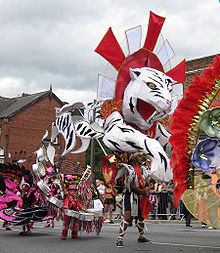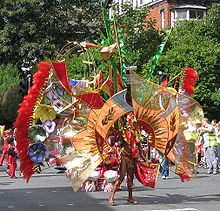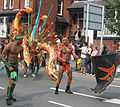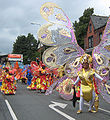- Leeds West Indian Carnival
-
The Leeds Carnival, also called the Leeds West Indian Carnival or the Chapeltown Carnival, is the longest running West Indian carnival in Europe, having been going since 1967. The carnival is held in the Chapeltown and Harehills parts of Leeds every August bank holiday[1] weekend. 150,000 people were estimated to have attended the 2009 event.[2]
It is a 3-day event, climaxing in a carnival procession on Bank Holiday Monday, which starts and finishes in Potternewton Park in Chapeltown. A parade of floats and dancers makes its way along Harehills Avenue, down Roundhay Road in Harehills, along Barrack Road and back along Chapeltown Road to the park, where a wide range of stages and stalls provide entertainment and refreshment for carnival-goers. Since 2005 this event has been covered by the BBC station 1xtra in conjunction with Notting Hill Carnival.[3]
Contents
Carnival Queen and King
The Carnival Queen is chosen on the Friday before, and in 2008 for the first time a Carnival King was chosen: they were Davina Williams and Tyrone Henry.[4] The 2009 King and Queen were Tony and Nicole Isles, who are father and daughter.[2]
History
Its founders were Arthur France, then a Leeds University student from Saint Kitts, who is longstanding Chairman, and Ian Charles, who was still Co-ordinator in 2008.[5] Arthur France proposed what would be the first Caribbean-style outdoor carnival organized by people of Caribbean origin in Europe. As the local Caribbean association was not forthcoming, he formed his own committee, and Ian Charles's home became a factory for costumes.[6] Five contestants entered the first Carnival Queen Show, won by Vicky Seal as the Sun Goddess. They joined bands and dancers in a procession from Potternewton Park to Leeds Town Hall, where a steel band competition was followed by a dance. About a thousand people attended. The Leeds performers were invited to participate in the Notting Hill Carnival later the same year.[6]
In the 1970s a procession route was established from Potternewton Park and back again via the city centre. The steel bands were on human-powered wheeled platforms.[6] In 1977 crowds of 10,000 were reported for a largely trouble-free 3-day event (in contrast to the Notting Hill Carnival of the same time).[6]
The 1980s established a shorter route around Chapeltown and Harehills, and also sponsorship by local organizations. A Carnival Prince and Princess (children 3 to 13) were also chosen. Attendance reached 40,000 in 1988.[6]
In 1990 the Carnival was essentially trouble-free, but 3 people died in violence in the area afterwards.[6][7] The decade saw increased professionalism by the now very experienced Carnival Committee and the introduction of lorries to carry bands. 1997 was the 30th anniversary and Arthur France received the MBE for his work with the local community. Arthur France's daughter is now a teaching assistant at St. Peters CofE Primary School
2007 was the 40th anniversary, with crowds of 100,000 for the first time.[8] It was also the 25th anniversary of the Leeds West Indian Centre, and the bicentenary of the abolition of transatlantic slavery. Ian Charles also received the MBE.[8]
Gallery
References
- ^ The last Monday in August, a holiday in England
- ^ a b BBC News 31 August 2009 Thousands attend oldest carnival
- ^ http://www.bbc.co.uk/1xtra/carnival09/feature/whatson.shtml
- ^ Yorkshire Evening Post 26 August 2008
- ^ "Carnival Through the Years, 1967". Leeds West Indian Carnival Website. http://www.leedscarnival.co.uk/index.php?option=content&task=view&id=2&Itemid=35. Retrieved 2008-08-28.
- ^ a b c d e f Max Farrar A short history of the Leeds West Indian Carnival 1967-2000
- ^ Yorkshire Evening Post 28 August 1990
- ^ a b Yorkshire Evening Post 28 August 2007 Leeds Carnival's 100,000 crowd breaks record
See also
External links
- www.leedscarnival.co.uk Leeds Carnival Organizers' website
- BBC NEWS Leeds enjoys 41st Carnival
- BBC image galleries Pictures of 2008 Carnival
Categories:- Leeds
- Carnivals in the United Kingdom
- Chapeltown, Leeds
- Harehills
Wikimedia Foundation. 2010.











